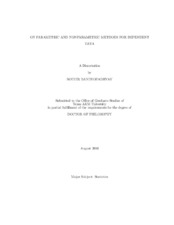| dc.contributor.advisor | Lahiri, Soumendra N. | |
| dc.creator | Bandyopadhyay, Soutir | |
| dc.date.accessioned | 2011-10-21T22:02:53Z | |
| dc.date.accessioned | 2011-10-22T07:09:10Z | |
| dc.date.available | 2011-10-21T22:02:53Z | |
| dc.date.available | 2011-10-22T07:09:10Z | |
| dc.date.created | 2010-08 | |
| dc.date.issued | 2011-10-21 | |
| dc.date.submitted | August 2010 | |
| dc.identifier.uri | https://hdl.handle.net/1969.1/ETD-TAMU-2010-08-8277 | |
| dc.description.abstract | In recent years, there has been a surge of research interest in the analysis of time series
and spatial data. While on one hand more and more sophisticated models are being
developed, on the other hand the resulting theory and estimation process has become
more and more involved. This dissertation addresses the development of statistical
inference procedures for data exhibiting dependencies of varied form and structure.
In the first work, we consider estimation of the mean squared prediction error
(MSPE) of the best linear predictor of (possibly) nonlinear functions of finitely many
future observations in a stationary time series. We develop a resampling methodology
for estimating the MSPE when the unknown parameters in the best linear predictor
are estimated. Further, we propose a bias corrected MSPE estimator based on the
bootstrap and establish its second order accuracy. Finite sample properties of the
method are investigated through a simulation study.
The next work considers nonparametric inference on spatial data. In this work
the asymptotic distribution of the Discrete Fourier Transformation (DFT) of spatial
data under pure and mixed increasing domain spatial asymptotic structures are
studied under both deterministic and stochastic spatial sampling designs. The deterministic
design is specified by a scaled version of the integer lattice in IRd while
the data-sites under the stochastic spatial design are generated by a sequence of independent
random vectors, with a possibly nonuniform density. A detailed account
of the asymptotic joint distribution of the DFTs of the spatial data is given which, among other things, highlights the effects of the geometry of the sampling region and
the spatial sampling density on the limit distribution. Further, it is shown that in
both deterministic and stochastic design cases, for "asymptotically distant" frequencies,
the DFTs are asymptotically independent, but this property may be destroyed if
the frequencies are "asymptotically close". Some important implications of the main
results are also given. | en |
| dc.format.mimetype | application/pdf | |
| dc.language.iso | en_US | |
| dc.subject | Bootstrap | en |
| dc.subject | Mean squared prediction error | en |
| dc.subject | second order bias correction | en |
| dc.subject | tilting | en |
| dc.subject | Asymptotic independence | en |
| dc.subject | Central limit theorem | en |
| dc.subject | DFT | en |
| dc.subject | Random field | en |
| dc.subject | Spatial processes | en |
| dc.subject | Spatial design. | en |
| dc.title | On Parametric and Nonparametric Methods for Dependent Data | en |
| dc.type | Thesis | en |
| thesis.degree.department | Statistics | en |
| thesis.degree.discipline | Statistics | en |
| thesis.degree.grantor | Texas A&M University | en |
| thesis.degree.name | Doctor of Philosophy | en |
| thesis.degree.level | Doctoral | en |
| dc.contributor.committeeMember | Carroll, Raymond J. | |
| dc.contributor.committeeMember | Sherman, Michael | |
| dc.contributor.committeeMember | North, Gerald R. | |
| dc.type.genre | thesis | en |
| dc.type.material | text | en |


